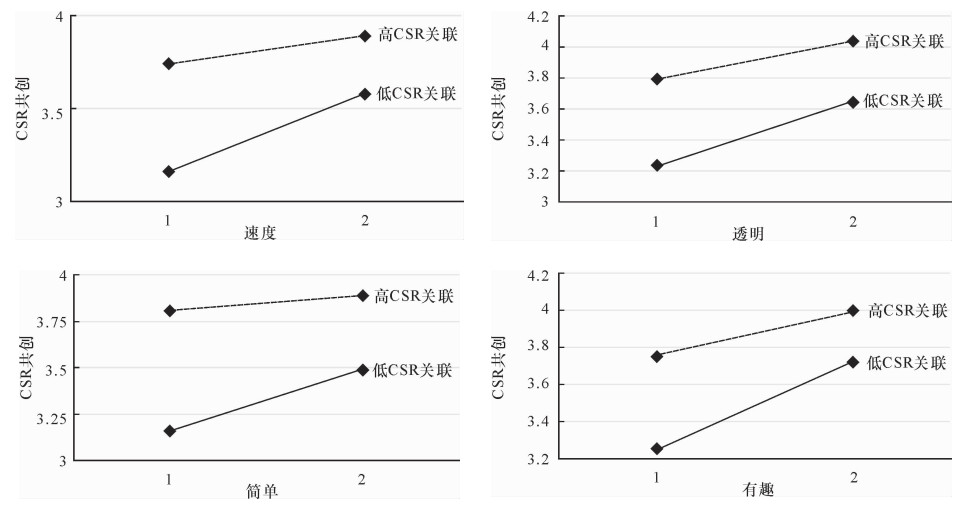Digital Experience Environment, Customer-Enterprise Social Value Co-creation and Customer Engagement
-
摘要: 顾客—企业社会价值共创通过整合顾客资源,实现企业价值与社会公益价值,对于企业可持续发展至关重要。根据认知心理学的自我决定理论、意义建构理论和归因理论,以参与过顾客—企业社会价值共创的顾客群体为调研对象,实证分析了数字化体验环境、顾客—企业社会价值共创、顾客契合及社会责任关联之间的关系。结果发现:数字化体验环境的速度、透明、简单及有趣特征会促使顾客—企业社会价值共创,而顾客—企业社会价值共创会进一步提升顾客契合;社会责任关联负向调节数字化体验环境与顾客—企业社会价值共创之间的关系。从而丰富了顾客参与企业社会责任活动的驱动因素及社会责任与顾企关系的影响研究,为企业的可持续发展决策提供参考。Abstract: Customer-enterprise social value co-creation, through the integration of customer resources, to achieve enterprise value and social public welfare value, is very important for the sustainable development of enterprises. By employing the self-determination theory, meaning construction theory and attribution theory of cognitive psychology, this paper empirically analyzes the relationship among digital experience environment, customer-enterprise social value co-creation, customer engagement and social responsibility relevance by taking customers who have participated in customer-enterprise social value co-creation as research objects. The results show that the characteristics of speed, transparency, simplicity and interest of digital experience environment will promote the co-creation of customer-enterprise social value; on the basis of digital experience environment promoting customer-enterprise social value co-creation, customer-enterprise social value co-creation will further enhance customer engagement; social responsibility relevance negatively adjusts the relationship between speed, transparency, simplicity, interest and co-creation of customer-enterprise social value. This paper enriches the research on the driving factors of customer engagement in corporate social responsibility activities and the influence of social responsibility and the relationship between customer and enterprise, and provides decision-making reference for the sustainable development of enterprises.
-
表 1 量表的信度和效度检验
变量 测量题项 因子载客 Cronbach'α系数 KMO CR 参考
文献速度 当我向企业发出请求后,我能够快速得到企业的回应 0.711*** 0.696 0.665 0.701 [3] (SP) 企业能够及时回复我提出的问题和意见 0.687*** 我在企业平台操作时,可以几乎无时间延迟地获得想要的信息 0.579*** 透明 企业会定期披露社会责任共创项目的进展情况 0.682*** 0.688 0.664 0.690 [10][24] (TR) 企业会将社会责任共创项目的执行结果反馈给用户 0.667*** 企业注重社会责任共创项目的自我监督和社会监督 0.612*** 简单 企业提供的社会责任共创项目非常方便我加入 0.672*** 0.690 0.669 0.691 [25] (SI) 企业提供的社会责任共创项目的操作工具非常容易学会 0.658*** 企业提供的社会责任共创项目的操作工具非常容易使用 0.628*** 有趣 企业提供的社会责任共创项目非常有趣 0.657*** 0.751 0.763 0.753 [26] (IN) 参与企业的社会责任共创项目对我来说就像是一种享受 0.691*** 参与企业的社会责任共创项目可以改善我的心情 0.643*** 参与企业的社会责任共创项目让我很放松 0.644*** CSR共创 我愿意投入智力参与企业的社会责任共创项目 0.691*** 0.763 0.772 0.766 [27] (CC) 我愿意投入体力参与企业的社会责任共创项目 0.734*** 我愿意投入时间参与企业的社会责任共创项目 0.637*** 我愿意投入情感参与企业的社会责任共创项目 0.612*** 顾客契合 我花费大量时间使用该企业提供的产品或服务 0.713*** 0.850 0.879 0.851 [28] (CE) 没有该企业,我的生活会不一样 0.722*** 任何与该企业有关的事情都会引起我的关注 0.660*** 我喜爱与朋友分享使用该企业产品或服务的经验 0.681*** 向他人介绍有关该企业情况时,我会介绍得很详细 0.691*** 当周围人也使用该企业产品或服务时,我感到使用该企业产品或服务更开心 0.721*** CSR关联
(CB)企业赞助的慈善公益活动都与企业直接相关 0.742*** 0.793 0.793 0.795 [7] 企业所从事的社会责任活动大多数都与消除或降低企业活动对社会带来的负面影响相关 0.715*** 企业参与或赞助的环境保护活动都与企业所处的行业相关 0.658*** 企业能妥善处理经营中产生的各种废弃物、危险品 0.685*** 注:***表示P < 0.001。 表 2 Pearson相关系数与AVE平方根值
变量 1 2 3 4 5 6 7 速度 0.665 透明 0.620 0.653 简单 0.585 0.575 0.654 有趣 0.596 0.639 0.612 0.659 CSR共创 0.576 0.628 0.552 0.647 0.673 顾客契合 0.590 0.566 0.626 0.658 0.656 0.699 CSR关联 0.612 0.633 0.618 0.647 0.639 0.688 0.704 表 3 各变量的均值、标准差和相关系数
变量 平均值 标准差 1 2 3 4 5 6 7 8 9 10 性别 1.492 0.501 1 年龄 2.856 0.819 0.005 1 学历 2.429 0.883 -0.031 -0.101 1 速度 3.549 0.825 -0.044 -0.070 -0.024 1 透明 3.592 0.811 0 -0.021 0.043 0.620*** 1 简单 3.552 0.825 -0.007 -0.001 -0.020 0.585*** 0.575*** 1 有趣 3.591 0.794 0.014 -0.044 0.007 0.596*** 0.639*** 0.612*** 1 CSR共创 3.617 0.801 0.076 0.058 -0.036 0.576*** 0.628*** 0.552*** 0.647*** 1 顾客契合 3.558 0.804 0.010 0.024 0.016 0.590*** 0.566*** 0.626*** 0.658*** 0.656*** 1 CSR关联 3.616 0.798 0.018 0.044 -0.004 0.612*** 0.633*** 0.618*** 0.647*** 0.639*** 0.688*** 1 注:*表示P < 0.05,**表示P < 0.01,***表示P < 0.001。 表 4 中介效应
变量 顾客契合 CSR共创 顾客契合 模型1 模型2 模型3 性别 0.026(0.418) 0.126*(2.033) -0.010(-0.162) 年龄 0.055(1.463) 0.084*(2.211) 0.032(0.865) 学历 0.024(0.687) -0.029(-0.812) 0.032(0.953) 速度 0.186***(3.555) 0.168** (3.189) 0.139**(2.718) 透明 0.084(1.542) 0.258***(4.700) 0.012(0.214) 简单 0.258***(5.031) 0.106* (2.055) 0.228***(4.601) 有趣 0.333***(5.940) 0.316***(5.613) 0.244***(4.317) CSR共创 0.282***(5.192) R2 0.545 0.539 0.582 调整R2 0.535 0.528 0.571 F值 53.305*** 51.890*** 53.904*** 注:*表示P < 0.05,**表示P < 0.01,***表示P < 0.001,括号内为t值,下表同。 表 5 调节效应(因变量:CSR共创;自变量:速度/透明)
变量 模型1 模型2 模型3 模型4 模型5 模型6 性别 0.162*(2.219) 0.129 (1.961) 0.100 (1.580) 0.118 (1.700) 0.107 (1.680) 0.091 (1.445) 年龄 0.096* (2.141) 0.057 (1.403) 0.049 (1.250) 0.064 (1.500) 0.043 (1.094) 0.039 (1.017) 学历 -0.008 (-0.187) -0.016 (-0.435) -0.024 (-0.678) -0.049 (-1.232) -0.040 (-1.091) -0.039 (-1.091) 速度 0.571*** (12.888) 0.303*** (5.951) 0.283*** (5.782) 透明 0.624*** (14.539) 0.376*** (7.367) 0.340*** (6.633) CSR关联 0.446*** (8.513) 0.359*** (6.774) 0.397*** (7.637) 0.351*** (6.674) 速度与CSR关联 -0.160*** (-5.223) 透明与CSR关联 -0.108***(-3.586) R2 0.352 0.474 0.516 0.408 0.501 0.521 调整R2 0.344 0.466 0.507 0.401 0.493 0.512 F值 42.717*** 56.449*** 55.535*** 54.147*** 62.891*** 56.537*** ΔR2 0.352 0.122 0.042 0.408 0.093 0.02 ΔF值 42.717*** 72.480*** 27.275*** 54.147*** 58.324*** 12.857*** 表 6 调节效应(因变量:CSR共创;自变量:简单/有趣)
变量 模型1 模型2 模型3 模型4 模型5 模型6 性别 0.126 (1.690) 0.109 (1.631) 0.095 (1.479) 0.105 (1.540) 0.100 (1.575) 0.084 (1.374) 年龄 0.056 (1.209) 0.034 (0.830) 0.035 (0.878) 0.081 (1.945) 0.055 (1.415) 0.040 (1.053) 学历 -0.015 (-0.349) -0.021 (-0.545) -0.020 (-0.544) -0.027 (-0.691) -0.027 (-0.735) -0.029 (-0.823) 简单 0.536*** (11.821) 0.249*** (4.831) 0.205*** (4.064) 有趣 0.656***(15.264) 0.413*** (7.854) 0.358*** (6.927) CSR关联 0.480*** (8.986) 0.405*** (7.591) 0.373*** (7.131) 0.318*** (6.176) 简单与CSR关联 -0.157*** (-5.152) 有趣与CSR关联 -0.145***(-5.043) R2 0.315 0.455 0.498 0.432 0.511 0.548 调整R2 0.306 0.447 0.488 0.424 0.503 0.539 F值 36.057*** 52.320*** 51.582*** 59.603*** 65.425*** 63.016*** ΔR2 0.315 0.141 0.043 0.432 0.079 0.037 ΔF值 36.057*** 80.744*** 26.545*** 59.603*** 50.858*** 25.436*** 表 7 中介效应
变量 顾客契合 CSR共创 顾客契合 模型1 模型2 模型3 性别 0.026(0.418) 0.069(1.268) 0.003(0.055) 年龄 0.055(1.463) 0.025(0.748) 0.047(1.300) 学历 0.024(0.687) -0.038(-1.242) 0.037(1.087) 速度 0.186***(3.555) 0.176***(3.817) 0.129*(2.502) 透明 0.084(1.542) 0.260***(5.406) -0.001(-0.016) 简单 0.258***(5.031) 0.157***(3.487) 0.206***(4.118) 有趣 0.333***(5.940) 0.311***(6.294) 0.231***(4.052) CSR共创 0.328***(5.297) R2 0.545 0.629 0.583 调整R2 0.535 0.62 0.572 F值 53.305*** 75.168*** 54.209*** 表 8 调节效应
变量 模型1 模型2 模型3 模型4 性别 0.045(0.792) 0.033(0.584) 0.040(0.689) 0.027(0.502) 年龄 -0.010(-0.293) -0.022(-0.626) -0.026(-0.723) -0.018(-0.532) 学历 -0.034(-1.058) -0.050(-1.586) -0.030(-0.918) -0.039(-1.257) 速度 0.302***(6.889) 透明 0.354***(7.763) 简单 0.259***(5.738) 有趣 0.378***(8.153) CSR关联 0.400***(8.432) 0.390***(8.344) 0.434***(9.073) 0.367***(7.936) 速度与CSR关联 -0.145***(-5.281) 透明与CSR关联 -0.100***(-3.730) 简单与CSR关联 -0.125***(-4.584) 有趣与CSR关联 -0.116***(-4.476) R2 0.594 0.602 0.576 0.618 调整R2 0.586 0.594 0.568 0.611 F值 75.978*** 78.595*** 70.627*** 84.101*** ΔR2 0.036 0.018 0.029 0.025 ΔF值 27.894*** 13.913*** 21.014*** 20.033*** -
[1] 田虹, 姜春源. 社会责任型人力资源管理对员工创新行为影响的研究——基于劳动关系视角下的链式中介作用[J]. 广东财经大学学报, 2020(6): 42-50. https://song.cbpt.cnki.net/WKG/WebPublication/paperDigest.aspx?paperID=95ef5af3-e3fc-4b64-a3d8-58917ba7d8af [2] LANE A B, DEVIN B. Operationalizing stakeholder engagement in CSR: a process approach[J]. Corporate Social Responsibility and Environmental Management, 2018, 25(3): 267-280. doi: 10.1002/csr.1460 [3] 史雁军. 数字化客户管理[M]. 北京: 清华大学出版社, 2018: 161-178. [4] 余义勇, 杨忠. 价值共创的内涵及其内在作用机理研究述评[J]. 学海, 2019(2): 165-172. doi: 10.3969/j.issn.1001-9790.2019.02.020 [5] RASOOL A, SHAH F A, ISLAM J U. Customer engagement in the digital age: a review and research agenda[J]. Current Opinion in Psychology, 2020, 36: 96-100. doi: 10.1016/j.copsyc.2020.05.003 [6] 刘凤军, 孔伟, 李辉. 企业社会责任对消费者抵制内化机制研究——基于AEB理论与折扣原理的实证[J]. 南开管理评论, 2015(1): 52-63. doi: 10.3969/j.issn.1008-3448.2015.01.007 [7] 辛杰, 张兰燕. 大数据背景下企业生态系统社会责任的理念变迁与互动演进[J]. 广东财经大学学报, 2018(5): 20-28. https://song.cbpt.cnki.net/WKG/WebPublication/paperDigest.aspx?paperID=b5e9605a-bed8-4ccc-ad65-8b0b055e94fe [8] POPE S, WÆRAAS A. CSR-washing is rare: a conceptual framework, literature review, and critique[J]. Journal of Business Ethics, 2016, 137(1): 173-193. doi: 10.1007/s10551-015-2546-z [9] 王新成, 李垣. 企业合作、同行竞争与慈善捐赠[J]. 财经论丛, 2020(12): 88-97. doi: 10.3969/j.issn.1004-4892.2020.12.010 [10] 刘小平, 邓文香. 虚拟CSR共创?消费者互动与共创绩效——基于扎根理论的单案例研究[J]. 管理案例研究与评论, 2019(5): 509-520. https://www.cnki.com.cn/Article/CJFDTOTAL-GLAL201905005.htm [11] RYAN R M, DECI E L. Self-determination theory and the facilitation of intrinsic motivation, social development, and well being[J]. American Psychologist, 2000, 55(1): 68-78. doi: 10.1037/0003-066X.55.1.68 [12] 范晓屏, 韩洪叶, 孙佳琦. 网站生动性和互动性对消费者产品态度的影响——认知需求的调节效应研究[J]. 管理工程学报, 2013(3): 196-204. doi: 10.3969/j.issn.1004-6062.2013.03.027 [13] MERLO O, EISINGERICH A, AUH S, et al. The benefits and implementation of performance transparency: the why and how of letting your customers 'see through' your business[J]. Business Horizons, 2018, 61(1): 73-84. doi: 10.1016/j.bushor.2017.09.007 [14] IDOWU S O, CAPALDI N, FIFKA M S, et al. Dictionary of corporate social responsibility: CSR, sustainability, ethics and governance[M]. Cham: Springer International Publishing, 2014: 293-315. [15] 余译青, 王宇成, 朱庆华. 数字化助推概念解析及研究进展[J]. 中国图书馆学报, 2021(1): 108-122. https://www.cnki.com.cn/Article/CJFDTOTAL-ZGTS202101008.htm [16] JURIETTI E, MANDELLI A, FUDURIC M. How do virtual corporate social responsibility dialogs generate value? a case study of the unilever sustainable living lab[J]. Corporate Social Responsibility & Environmental Management, 2017, 24(5): 357-367. doi: 10.1002/csr.1407 [17] HARWOOD T, GARRY T. An investigation into gamification as a customer engagement experience environment[J]. Journal of Services Marketing, 2015, 29(6-7): 533-546. doi: 10.1108/JSM-01-2015-0045 [18] 姚作为, 刘人怀. 企业社会责任对消费者的影响: 研究流派与未来展望[J]. 科学决策, 2012(11): 62-84. https://www.cnki.com.cn/Article/CJFDTOTAL-KXJC201211006.htm [19] 吕迪伟, 冉启斌, 蓝海林. 认知学派与战略管理思想演进?发展与争鸣[J]. 南开管理评论, 2019(3): 214-224. doi: 10.3969/j.issn.1008-3448.2019.03.019 [20] BIGGEMANN S, WILLIAMS M, KRO G. Building in sustainability, social responsibility and value co-creation[J]. Journal of Business & Industrial Marketing, 2014, 29(4): 304-312. doi: 10.1108/JBIM-08-2013-0161 [21] O'BRIEN I M, JARVIS W, SOUTAR G N. Integrating social issues and customer engagement to drive loyalty in a service organization[J]. Journal of Services Marketing, 2015, 29(6-7): 547-559. doi: 10.1108/jsm-02-2015-0085 [22] HUSSAIN K, JING F, JUNAID M, et al. The role of co-creation experience in engaging customers with service brands[J]. Journal of Product & Brand Management, 2020, 30(1): 12-27. http://www.researchgate.net/publication/344092363_The_role_of_co-creation_experience_in_engaging_customers_with_service_brands [23] 骆紫薇, 黄晓霞, 陈斯允, 等. 企业为何履行社会责任却落得"伪善"名声?——企业社会责任类型和感知品牌伪善间的关系[J]. 心理科学进展, 2017(10): 1642-1655. https://www.cnki.com.cn/Article/CJFDTOTAL-XLXD201710002.htm [24] 肖红军, 胡叶琳, 许英杰. 企业社会责任能力成熟度评价——以中国上市公司为例[J]. 经济管理, 2015(2): 178-188. doi: 10.3969/j.issn.1671-0975.2015.02.078 [25] 许慧敏, 周天舒, 辛冲. 虚拟顾客环境特征对新产品开发中顾客参与的影响[J]. 技术经济, 2016(11): 12-21. https://www.cnki.com.cn/Article/CJFDTOTAL-JSJI201611002.htm [26] 孟艳华, 罗仲伟, 廖佳秋. 网络直播内容价值感知与顾客契合[J]. 中国流通经济, 2020(9): 56-66. https://www.cnki.com.cn/Article/CJFDTOTAL-ZGLT202009006.htm [27] CERMAK D S P, FILE K M, PRINCE R A. Customer participation in service specification and delivery[J]. Journal of Applied Business Research, 1994, 10(2): 90-97. http://gateway.proquest.com/openurl?res_dat=xri:pqm&ctx_ver=Z39.88-2004&rfr_id=info:xri/sid:baidu&rft_val_fmt=info:ofi/fmt:kev:mtx:article&genre=article&jtitle=Journal%20of%20Applied%20Business%20Research&atitle=Customer%20participation%20in%20service%20specification%20and%20delivery [28] VIVEK S D. A scale of consumer engagement[D]. Alabama: The University of Alabama, 2009. [29] 樊帅, 田志龙, 张丽君. 虚拟企业社会责任共创心理需要对消费者态度的影响研究[J]. 管理学报, 2019(6): 883-895, 948. https://www.cnki.com.cn/Article/CJFDTOTAL-GLXB201906011.htm [30] FUELLER J. Refining virtual co-creation from a consumer perspective[J]. California Management Review, 2010, 52(2): 98-122. http://www.emeraldinsight.com/servlet/linkout?suffix=b42&dbid=16&doi=10.1108%2FIJCHM-03-2014-0151&key=10.1525%2Fcmr.2010.52.2.98 -





 下载:
下载:

